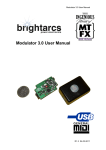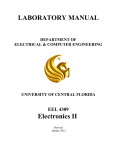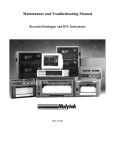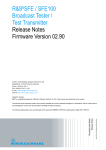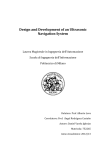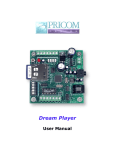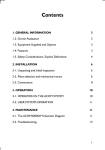Download tinyTesla User Manual
Transcript
© 2015 oneTesla LLC tinyTesla User Manual Version 1.5 User Manual v1.5 i Running list of errata You are currently reading version 1.5 of the tinyTesla User Manual. Before continuing, go to onetesla.com/downloads and check that v1.5 is the most up-to-date version. If not, download the errata or the latest version of the manual. This page will be continuously updated with corrections. February 2015 Early kits may have the following extra parts, which are erroneous and may be omitted: n female molex connector n one surplus large ring terminal n one surplus 6mm screw March 2015 In v1.0 of the manual, on page 3, the color code for the 68Ω resistors R2 and R3 was incorrect. The correct color code is blue gray black. April 2015 In Step 12 and in the troubleshooting section, the reading from the top of the secondary to the ground pin of the power cord should be ~600Ω (not ~400). In Step 6-J, regarding the fiber optic receiver, kit builders have noticed that soldering this component at too high a temperature can damage it. We are not exactly sure of the proper temperature range, but we recommend soldering at no higher than 400°C. May 2015 An extra IGBT testing procedure has been added to Step 15. Some kits have stability issues with the USB interrupter. There are several fixes for this problem, which relates to the Zener diodes. The first option is to use a USB 3.0 port and omit the Zener diodes. The second option is to replace the 3.3V Zener diodes with 3.6V Zener diodes. Contact us at [email protected] if you need them sent to you. If you receive extra parts outside of the kit in your shipping box, they are for use in place of the parts in the kit. In particular, some shipments have replacement Zener diodes for the interrupter. June 2015 Note added to glue down the bolt in the endcap during assembly. In Step 15, multimeter check of IGBTs section, sentence changed from “Meter between pins 1 and 3 of X1, the large 3-pin connector. You should read open.” to “You should not read a dead short.“ Properly sized heat sink template added. September 2015 Removed references to the tinyTesla interrupter chassis as it is purely cosmetic and will no longer be included in the kit. User Manual v1.5 ii Welcome! With tinyTesla you’ll learn about electronics, flex your soldering muscles, shoot lightning and play music using electricity! A Tesla coil is a device that uses resonant circuits and alternating current to produce extremely high voltages. Originally invented by Nikola Tesla in the late 1800s, Tesla coils have progressed from spark-gap circuits to designs involving modern solid-state switching devices such as MOSFETs and IGBTs. While there are many types of Tesla coils, what they all have in common are air-cored induction coils. Using a Tesla coil is the best way to produce a continuous high-voltage streamer. We’ve designed a Tesla coil kit that’s both easy to build and beautiful. tinyTesla is an SSTC, or “solid state Tesla coil,” which balances performance, musical ability, and reliability. But be careful! Building hardware can be tricky if you’re inexperienced or don’t have the proper equipment. Work with good tools, pay close attention, and ask for help when you need it. Need help? Go to our support forum at onetesla.com/forum Need replacement parts? Contact us at [email protected] Check out all of our educational tutorials at onetesla.com/tutorials Check out our other kits at www.onetesla.com! Note: We try our best to keep all images and instructions consistent with the latest revision of the tinyTesla hardware, but the photos in this manual and on our website are not always identical to the components you receive in your kit. They will, however, maintain the same functionality. Most of all, have fun! What’s in the tinyTesla kit? Feedback antenna Spun aluminum toroid Primary coil Breakout point USB-MIDI interrupter (shown here with chassis that is no longer included in the kit) Secondary coil AC power cable Fiber optic transmitter Fiber optic receiver Fiber optic cable User Manual v1.5 1 Safety Warnings ADULT SUPERVISION REQUIRED Adult Supervision Required Users under 18 should only use this kit under the supervision of an experienced adult. Pacemaker Warning Persons with electronic medical implants such as pacemakers should not be near the Tesla coil during operation. EMI from the coil may interfere with the pacemaker’s function. Ozone Warning ADULT SUPERVISION ADULT REQUIRED SUPERVISION REQUIRED The high temperature of the Tesla coil streamers causes the gases that make up air to form other compounds, including ozone (which can often be smelled when the coil is in operation) and nitrogen oxides. Keep the Tesla coil work area well-ventilated to prevent the buildup of irritating gases such as ozone and nitrogen oxides, which become toxic if concentrated. Fire Hazard The arcs from the Tesla coil can set flammable objects on fire. Keep all flammable objects away from the Tesla coil while it is in operation. ADULT SUPERVISION REQUIRED Ear Protection Recommended The Tesla coil output is loud; ear protection is recommended. Eye Glasses Required Always wear eye protection while soldering. Power semiconductors may overheat and fail violently, causing a shrapnel hazard. Wear safety glasses when working on the board while it is energized. Only power up the board when it is fully enclosed inside the chassis. RF Warning Keep sensitive electronics away from the Tesla coil at all times. Use the entire length of the included fiber optic cable to distance your computer from the Tesla coil. ADULT SUPERVISION REQUIRED ADULT SUPERVISION REQUIRED User Manual v1.5 2 Before you begin Be up-to-date Ensure you have the latest version of the manual, and if not, download the errata sheet or the newest version at onetesla.com/downloads. Read the tutorials All of our tutorials can be found at onetesla.com/tutorials nSoldering tutorial (http://onetesla.com/tutorials/how-to-solder) nDe-soldering tutorial (http://onetesla.com/tutorials/how-to-desolder) nHow a Tesla coil works Observe good workspace practices nKeep your workspace neat and orderly. nAlways obey common sense. nDo not continue work if at any point you feel uncomfortable with the hazards a challenging electronics project poses. nUse caution when soldering; lead is hazardous, and the iron is extremely hot. Step 1: Assemble Have the right equipment Having the proper tools for electronic assembly, particularly a powerful enough soldering iron, will make your life much easier! Here are the tools you need to assemble your Tesla coil: ntemperature-controlled soldering iron, 40W minimum nrosin-core solder of an appropriate thickness nsafety glasses nsmall pliers nflush cutters nwire strippers nsmall screwdriver nhot glue gun nmultimeter Optional but useful: npacking tape n masking tape n solder wick or other desoldering tools You will also need.... n spray-on or paint-on polyurethane varnish n a mini USB cable to connect to the tinyTesla interrupter n a laptop running 1T Panel or other MIDI control software the interrupter The interrupter is the Tesla coil’s music controller. It connects via a mini USB cable to a computer, and appears as a MIDI device. Assemble it first because you will need to use it to ensure the low-voltage side of the main driver board is working. The interrupter is also a small board with few parts, which—if soldered correctly—should work right away. A. B. C. D. E. F. G. H. Install R1 through R4. Install C1. Install CN1, the mini USB connector. Install zener diodes D1 and D2. Note that they are directional! Match the band on the diode to the band on the board. Don’t confuse them with the 1N4148 signal diodes, which look the same except for their part number. Install the socket of IC1. Do not solder the ATtiny directly to the board! Make sure that the notch on the socket matches the notch on the board. Do not solder the socket with the ATtiny inserted! Insert the ATtiny into its socket, making sure that the dot on the chip is on the same side as the notch on the socket. Install IC2, the optical transmitter. Careful! This component is delicate. Secure it with a bolt and nut before soldering it in. Install the slide switch. Don’t worry, the ATtiny microcontroller in your kit is already programmed. If you ever need to re-program your ATtiny, install a 6-pin header. Since your ATtiny comes programmed, we didn’t include one. User Manual v1.5 R1 1.5kΩ (brown green red) R2, R3 68Ω (blue grey black) R4 100Ω (brown black brown) C1 1uF (labeled 105) CN1 mini USB connector D1, D2 3.3V Zener Diodes IC1 ATtiny and socket IC2 optical transmitter slide switch 3 Step 2: Troubleshoot the interrupter The interrupter is powered over USB and can be controlled using our 1T Panel software available for download at onetesla.com/downloads. You will need a mini USB cable to connect to the interrupter. It behaves like a MIDI device and can also be controlled via other MIDI software. See Appendix A for a description of 1T Panel. The interrupter has two modes: live mode (switch to the right) and fixed mode (switch to the left). Note: every time you want to switch modes, you need to power cycle (unplug and plug back in) the interrupter. Place the switch in the live mode position (right-hand side). This places the interrupter into MIDI mode. Using a mini USB cable, connect the interrupter to a computer. Confirm that the USB device is recognized and does not throw an error. Use 1T Panel to raise and lower the power and confirm that the LED in the fiber optic transmitter raises and lowers in brightness accordingly. The interrupter set to live mode. Flip the switch to the left for fixed mode. If it doesn’t work USB device is not recognized or drops out... Interrupter doesn’t respond to software... n Confirm the ATtiny is installed in the correct orientation. n Check all parts carefully for correct values and orientations. n Check your soldering for bridges and/or cold joints. n Unplug all other USB devices. n If the interrupter drops out when you handle the USB cable, check your soldering of the USB connector. n Try a different computer to compare results. n (early kits) Replace your 3.3V Zener diodes with 3.6V Zener diodes. If using a USB 3.0 port, you can omit the Zeners altogether. n n Need help? If you encounter a problem that isn’t covered here, take a look at our online help forum at onetesla.com/forum. Someone else may have had the same problem and figured out a solution. Please post on the forum rather than emailing us for support, so that everyone can learn from how you resolved your problem! Ensure that the software you’re using is transmitting on MIDI channel 0. Ensure that the software you’re using is outputting to the appropriate USB port. User Manual v1.5 4 Step 3: Varnish the Secondary Your secondary coil needs a few thick insulating layers to keep it safe. A polyurethane paint-on or spray-on varnish works great. Coat your coil in at least three layers of varnish. It’s better to start this process early to allow enough time for the varnish to dry (typically one night per coat). Don’t skip this step! An unvarnished secondary will arc over immediately, even at low power. If you want a quick way to increase your insulating layer thickness, add some packing tape to your coil. Be very careful to remove all the air bubbles under the tape! To increase the effectiveness of the tape, cut the edge at a steep angle. The seam of the tape is the most likely place to have arcing, and cutting at a shallow angle increases the seam length, increasing the distance the sparks have to jump. Step 4: Install hardware on the heat sink We will take a brief interlude from soldering to attach some hardware on the heat sink. Since the IGBTs are mounted on the underside of the board, once we install them we can’t easily remove the circuit board to get access to the heat sink. A. B. Need a diagram? Go to Appendix B. Install four 6mm standoffs into the holes near the edge of the heat sink. Fasten the right-angle brackets to the heat sink using a 6mm M3 screw through the unthreaded hole in the bracket. The threaded holes should be on the side perpendicular to the surface of the heat sink! Threaded hole User Manual v1.5 5 Step 5: Install the Main Board’s Logic Components We’re splitting up the main board assembly process into two steps so that you can clearly see which components are related to the main board’s logic vs. its power. If you wish, you can troubleshoot the main board’s logic after this step to ensure that your construction is correct so far, but you can also install it all at once and troubleshoot the whole system all together later. A. B. C. D. E. F. G. H. Install R1. Note that it stands on its end (see image on right). Install C1—C3, 100uF electrolytic capacitors. You may need to straighten the leads to have them fit properly. Note the direction! There’s a white band on the negative side, and positive is marked on the board. Install capacitors C6—C9. They are all 1uF ceramic capacitors labeled 105 whose installation direction do not matter. Install D1 and D2, the 1N4148 signal diodes. Note that they are directional, and the band on the diode needs to match the band on the board. Install D3, the logic-side bridge rectifier. Install sockets for IC2 and IC5. Match the notch on the socket to the notch on the board. Remember, don’t solder the ICs directly to the board! Insert the ICs into their respective sockets. Remember to match the spot on the IC to the notch on the socket and the board! Install IC3 and IC4, the 15V and 5V voltage regulators. Don’t confuse the two! They look the same except for the part number. I. Install the 2-pin headers labeled JPHASE on the board and slide on the jumpers. The direction of the jumpers doesn’t matter for now. J. Install the optical fiber receiver. Be careful! This component is delicate. Soldering this component at too high a temperature can damage it. We recommend soldering at no higher than 400°C. Secure it with a 10mm bolt and M3 nut before soldering it in. K. Verify that T1, the line transformer, is rated for the appropriate voltage for your country (110V or 220V). Then solder it in. Please note that the top middle hole is a via that connects the top and the bottom sides of the board, not a hole for a T1 pin. L. Install X1, the AC power connector. Step A: installation of resistor R1. R1 4.7Ω (yellow violet gold gold) C1–C3 100uF electrolytic capacitor C6–C9 1uF ceramic capacitor (105) D1, D2 1N4148 signal diode D3 Logic-side bridge rectifier 14-pin socket 8-pin socket IC2 Schmitt trigger inverter 74HCT14 IC3 LM7815 15V voltage regulator IC4 LM7805 5V voltage regulator IC5 Dual Gate Driver UCC27425PE4 Phase jumpers and 2-pin header 110V jumper Optical receiver T1 Line transformer (110V or 220V) X1 3.96mm 3-pin header Why the pre-soldered component? The pre-soldered part on your board is a surface mount gate drive transformer (GDT). It’s tricky to solder this component by hand with a regular soldering iron so we did it for you using a heat gun. Through-hole gate drive transformers are bulky, and using this little surface-mount one was the only way we could keep your driver board tiny! Optional Logic Troubleshooting At this point, you can follow the troubleshooting procedure in step 14 to verify that your work so far is correct. You should first mount your board onto the heat sink. If you’re confident in your soldering abilities, you can just continue and troubleshoot later if necessary. At the end of the step, your board should look like this. User Manual v1.5 6 Install the Main Board’s Power Components Step 6: Before you begin this step, you should add another layer of varnish to the secondary! In this step, install all the power components except for the IGBTs, which have a special mounting procedure. A. B. C. D. E. F. Install R2 and R3. It’s very important that you install these resistors! They are bleeder resistors for the bus capacitors which drain their charge when you power off the unit. Failure to install these will result in capacitors that can’t drain their stored energy, and a board which is unsafe to service. Install C4 and C5, the bus capacitors. Note the direction! There’s a white band on the negative side, and positive is marked on the board. Install X2, the .1” 3-pin right-angle header for the primary and antenna. Install D4, the 400V bridge rectifier. If you are using a 110V kit you will need to install the 110V jumper next to the line transformer. Take the 3-inch piece of solid-core AWG 22 wire and cut it to size. Strip the ends and solder it in. If you are using a 220V kit DO NOT install this jumper. Install F1, the fuse clips and fuse. Clip the fuse into the clips to help them stay in place while soldering. Step 7: Install the IGBTs R2, R3 100kΩ (brown black yellow) C4, C5 47uF electrolytic capacitors X2 .1” right-angle header D4 400V bridge rectifier 110V jumper F1 10A 250V fuse and clips Step A Step E Step B The IGBTs have a special mounting procedure. They are mounted flush against the heat sink and soldered to the top of the board, not the bottom like the rest of the components. A. Ensure that the surface of the heat sink is clean. If there is any grease or grime, clean it away using rubbing alcohol. B. Using the outline in Appendix B as a guide, place the sil-pad on the heat sink. Place the IGBTs on the sil-pad and use nylon screws to hold them in place. C. Using pliers or your fingers, carefully bend the IGBTs 90 degrees at the point where the legs become thinner. D. Place the board over the IGBTs and position it so that the leads pass through the holes in the board. This should be easy if you have the IGBTs rotated at the correct angle, but can be tricky if they are not properly aligned. E. Screw down the board into the standoffs, so that it is mechanically secure. You may need to force the leads to bend a little bit to get the board to align to the standoffs. You want everything mechanically secure before soldering, so that you don’t put stress on the soldered joints. F. Double-check that that your IGBTs are not touching each other, and that they are not touching the heat sink. Tighten the nylon screws if needed. G. Solder in the IGBTs on the top of the board. You may find it easier to remove the IGBTs later if you leave the leads long. In the case of a problem, the IGBTs are usually the first part to fail, so if you stress your coil it’s likely that you will be replacing them! Step C Step D The completed board User Manual v1.5 7 Step 8: Wind the Primary If you haven’t already, finish varnishing your secondary before you proceed. The primary coil is 6 turns of Teflon wire that’s wound on top of the secondary turns, slightly above the bottom of the secondary coil. We strongly recommend putting an additional layer of electrical tape or kapton tape underneath the primary, on top of the secondary’s varnish, to add to the resiliency of your coil. A. B. C. Tape down the end of the primary to hold it in place. Wind 6 turns without overlapping the wire. Twist together the ends of the wire to hold the coil in place. Tighten the twist with a pair of pliers to remove any slack in the windings. If you coil the wire sufficiently tightly it will stay in place by itself. If you want it to be slip-proof, use a small amount of hot glue or tape to hold it in place. Just remember that if you need to add more varnish to your coil later, you will need to remove the primary! Step 9: A. B. C. D. E. Attach the Primary Connector Cut the red and yellow wires of your primary connector so that they are about half an inch long. Using wire strippers, remove about a quarter inch on insulation from the end. Leave the middle wire long. Cut about half an inch off the end of the primary wire to shorten it, and strip about a quarter inch of insulation. When you are finished with mounting the primary connector, it should reach just into the notch in the secondary tube to the connector on the main board. Excess wire is more likely to be arced to. Cut the piece of heat shrink in half and slide each half onto the primary wire. Solder the wires together. Slide the heat shrink tubing over the soldered connection and use the heat of your soldering iron to shrink the tubing. You could alternately insulate the connection with some electrical tape. Primary Antenna Primary User Manual v1.5 8 Step 10: Assemble and Attach the Antenna The antenna picks up the coil’s electric field and provides a feedback signal necessary for the Tesla coil’s control loop. The antenna is connected to the coil through the same header as the primary. A. B. C. D. Peel the protective paper off of the acrylic pieces that comprise the antenna base. Assemble the base of the antenna. The parts should press fit together, but you can use a little bit of glue if you want the base to be sturdier. Use two 10mm screws and nuts to fasten the antenna brass rod to the base. Strip the free end of the antenna wire and wrap it around one of the screws. Tighten the nut firmly to hold the rod and wire in place. Connect the long middle wire of the primary connector to the antenna’s brass rod in one of two ways: either solder it directly to the brass rod, or clamp it between the rod and a nut. Check with a multimeter to ensure continuity between the wire and the brass rod. Step 11: A. B. Solder the Ring Terminals Solder a large ring terminal to the loose wire at the top of the secondary (see picture). Burn away the enamel using a flame from a lighter, or use some fine- grit sandpaper. You may even be able to use the heat of your soldering iron to burn through it. Be careful handling the delicate, hair-thin wire of the secondary! Use a multimeter to verify that you have around 600Ω across the secondary. Any more resistance indicates a poor connection that you need to re-solder. Glue the small ring terminal over the nearest slot at the base of the secondary (see picture). Later on, you will place a screw through the terminal to fasten it to an angle bracket on the heat sink, in order to ground your secondary. Step B. Step A. User Manual v1.5 9 Step 12: A. Assemble the End Cap Build the end cap for the secondary according to the diagram. Don’t worry if it’s not pretty—remember that with the toroid mounted, you don’t see the end cap! DO NOT glue down the bolt in the cap. The bolt should be a little loose because when you mount the toroid, the bolt will be pulled up against the Which glue do I use? Hot glue is great because it’s sturdy enough to hold ring terminal, creating a secure connection. the coil together, but if you make an error you can still force apart the pieces. If you prefer your coil more drop-proof, use super glue or epoxy. Note that super glue clouds acrylic, so be sparing if you use it! B. Glue the end cap in place on top of the secondary tube. Rotate your tube so that the secondary wire is taut and does not sag into the tube! Sagging wire acts like a breakout point inside the secondary and will cause internal arcing. If you want to be extra-safe, you can insulate your exposed bit of wire with some hot glue. C. Check for continuity between the bolt and the bottom ring terminal to verify that the wire is still intact. D. Thoroughly remove any stray strings of hot glue inside the tube. Any stray bits inside the tube can result in internal arcing when you power up your coil later. Broken wire? If the wire breaks, simply peel off more wire from the top of the coil. Use a razor blade to separate out the top turn of wire. Place a small amount of glue between each layer to hold the end cap assembly together. User Manual v1.5 Place a small amount of glue on the rim to keep the cap in place. 10 Step 13: Mount the Secondary, Toroid and Breakout Point A. Place the secondary tube over the main board, orienting the notches appropriately. Use M3 screws to mount the tube. Don’t over-tighten! B. Plug in the primary coil connector. Step A. C. D. Mount the toroid onto the secondary tube and fasten it using an M6 nut. Place the breakout point straight across the toroid. It should stick out about 3 inches. The breakout point should simply lay across the top, but if you want to hold it in place you can use some aluminum tape. Step C. Step D. User Manual v1.5 11 Step 14: Full-system troubleshooting Do a Thorough Check First do a visual inspection of your board. The vast majority of problems are caused by faulty component installation, which can be caught before you apply power to the coil. Thoroughly check the following: n Signal diodes (1N4148s) and bridge rectifiers are oriented correctly. n Electrolytic capacitors are oriented correctly. n 5V and 15V regulators are in their correct locations and have not been swapped. n Correct chips are in each socket, and chips are installed in the proper direction. n Soldering looks neat and clean. Next, let’s do a multimeter check of the IGBTs.If something doesn’t check out here, DO NOT power up the board. Something is wrong with you IGBTs or their installation. n Meter between pins 1 and 3 of each IGBT and verify that you read a short. n Confirm that with the + probe of your multimeter on the middle pin of Q1 and the - probe of multimeter on the middle pin of Q2, you read open. n Meter between pins 1 and 3 of X1, the large 3-pin connector. You should not read a dead short. Startup and Shutdown Procedure A. B. C. You can now attempt to turn on the coil, as most failure modes result in the coil doing nothing or underperforming, rather than damaging the board. If you want to be more conservative, follow the complete troubleshooting procedure in Step 15. Before you follow the startup procedure, read through all of the procedures and failure modes described in the next pages to know what to expect! Start with no cables connected to your tinyTesla coil, and AC power cable UNPLUGGED. First, confirm that your interrupter is working by connecting it to a laptop and verifying that it responds normally by observing the output of the fiber optic transmitter. As you raise and lower the power, the output should become brighter and dimmer accordingly. Set whatever computer program you’re using to only slightly above its lowest power setting and pause output to the interrupter. Connect the fiber to the coil and the interrupter, and space the interrupter the full length of the fiber from the coil. D. E. F. G. Finally, check a few important mechanical things: n There are about 600 ohms between the toroid and the ground prong of the power plug. n The breakout point is mounted properly and is pointing in a direction away from the antenna. You should never arc to the antenna. n The wire at the top of the secondary is taut and not sagging into the secondary tube; likewise, there are no drips of glue or stray bits inside the secondary tube. n The antenna and primary connector are plugged in. You’re using the full length of the optical fiber to distance yourself and the interrupter from your Tesla coil. n Your USB cable is short and/or coiled tightly to avoid picking up noise. The control laptop is unplugged from its charger. Every time you turn on the coil Reference this startup procedure every time you turn on the coil! Every time you turn off the coil To turn off the coil, FIRST cut the interrupter signal first, THEN cut AC power. Cutting off the coil from AC power while the interrupter is still sending a signal can cause indeterminate states in the logic circuitry as the voltage rails sag, and can blow your IGBT bridge! FIRST plug the power cable into the coil, THEN plug it into AC power. Caution! The board is now energized. Proceed with extreme caution. Note that the coil can be loud when it turns on. This procedure ensures that you’re not handling the coil at the moment you power it up, in case it behaves unexpectedly. If the fuse blows or you notice something else unusual happen, UNPLUG THE COIL IMMEDIATELY and proceed to the troubleshooting steps ahead. Use your laptop to send a MIDI signal to the interrupter at low power. You should see and hear a small, clean-sounding spark coming from the breakout point. If it looks OK, slowly increase the power while watching for any problems such as flashover on the secondary, arcing to the antenna, arcing inside the coil, or any other strange behavior. To stop operation, use your control software to stop sending MIDI signals to the interrupter. Always stop your coil using the interrupter rather than cutting AC power! WAIT 5 MINUTES AFTER TURNING OFF THE COIL TO ALLOW CAPACITORS TO DISCHARGE. ADULT SUPERVISION User Manual v1.5 12 Common Problems and Solutions If it just works… Hooray! Good job following the directions. Share your success on our forum, and if you take great pictures or video we’ll showcase your build on our website and social media! If nothing happens… If you paid no attention to the direction of your primary winding, 50% of the time, your coil will do nothing! The phasing on the board needs to match the direction in which your primary is wound. Simply rotate the phasing jumpers and try again. If switching the phasing doesn’t help, don’t panic! The majority of issues are caused by poor soldering or an obvious mistake during assembly. Check the following: n Is your primary plugged in? n Is your interrupter actually outputting a signal? n Is the antenna positioned too far away? n Have you tried both phasing directions? n Is your coil plugged in and AC power working? n Is the fuse installed? Coils do nothing half the time! 50% of the time, your board’s phasing will not match the direction of your primary. Simply rotate your phasing jumpers and try again. Rotate the phasing jumpers 90° If you don’t find any obvious errors, continue to the troubleshooting guide in step 15. If you see an arc down the coil... Stop! Your driver is working (hooray!), but it’s outperforming your secondary. If you run the coil for any longer when you see arcs down the secondary, you’re going to degrade the wire’s enamel, and in the worst case, burn through the fine wire of the secondary. Fortunately there’s an easy solution, and that’s to add more varnish. Add varnish until you think there’s enough, and then add one more coat. There’s no such thing as too much varnish. If you need to just patch just one spot, you can use some hot glue, electrical tape or kapton tape. Put packing tape on top of the varnish to add extra insulation. If you hear an arc but don’t see it... Stop! Do not turn up the power! Increasing power on a coil that’s misbehaving never ends well. Always stop and fix the problem before turning it up. DO NOT CONTINUE OPERATING A COIL THAT’S ARCING OVER Taking good care of your secondary is essential to a long-lasting Tesla coil. As soon as there is an arc on the secondary, the insulation and wire enamel are compromised. The problem will only get worse with time unless you treat it right away. Stop operating immediately and patch the burned spot with a dab of hot glue, epoxy, varnish, or even tape. It’s possible to get a completely arc-free secondary that lasts a long time if you take care of it properly. Several things could be happening when there’s a weak output. The coil could be arcing on the inside rather than from the breakout point, which is caused by stray drips of glue or sagging wire on the inside of the secondary tube. Problems with the logic or gate drive signal could be causing the coil to perform very weakly. Check your 15V rail carefully using the procedure in Step 15. Check that nothing is shorting on the underside of the board. User Manual v1.5 13 If the spark sounds nTry moving the antenna around. Bringing it closer to the hissy or crackly… coil often improves performance, but remember not to bring it too close, or you will get arcing to it. n Check your grounding. The top of the secondary to the ground pin of the power cord should read ~600Ω. If it reads significantly higher you have a break somewhere which you need to hunt down and fix. nConsistent poor performance despite hearing gate drive buzz (see Step 15) can indicate an issue with gate drive signals. Check your 15V rail carefully. n You may have a bad solder joint which is picking up noise and affecting your driver’s logic signals. Inspect your sol dering on both the interrupter and the driver board. It nev er hurts to re-flow your joints with a good iron to fix po tential cold joints that are near-impossible to see. n Your USB cable may be poorly shielded and may be picking up noise. Keep in mind that a little bit of hissing or crackling is inherent to the operation of the coil, and that audio quality will not be perfect. If it makes a loud bang upon plugging into AC power... See, this is why we tell you to plug your AC cord into your coil first, then into an outlet! Fortunately this failure mode really isn’t likely to occur if you inspected your board properly and did a multimeter check of your IGBTs. Probable causes of this failure mode include the following: n IGBTs not properly isolated from the heat sink with sil-pad. Or, you used a metal screw instead of a nylon screw to fasten your IGBTs. n You installed an electrolytic capacitor backwards, resulting in the capacitor blowing. n A catastrophic solder bridge caused a short that made your fuse blow instantly. n You plugged in your coil while the interrupter was latched up at 100% duty cycle. n You plugged in your coil without the interrupter’s cable installed, resulting in continuous light entering the optical receiver, latching up the coil. Unplug your coil from AC power immediately, wait 5 minutes for the capacitors to discharge, and then examine your board carefully for errors. If you’ve made a catastrophic assembly mistake you should probably get help from somebody with more experience. User Manual v1.5 14 The fuse blows during operation... There are a few possible causes of spontaneous failure during operation. Interrupter latch-up happens when the microcontroller crashes, leaving the transmitter outputting high. A momentary large, loud spark from the coil and green flash from the fuse blowing is likely to be the interrupter latching up to 100% duty cycle rather than it’s typical <10% duty cycle. You can confirm the interrupter latched up by observing a continuous light from the optical transmitter. Next time you power up your coil, take care to coil your USB cable and unplug your control laptop from its AC charger. Ensure that your interrupter is fully enclosed inside its metal chassis. IGBT overload can occur if you draw too much current from the coil. If you run the coil at full power and draw an arc from it using a grounded metal object for example, you may stress the IGBTs too much. Other causes of failure during operation include overloading the coil by drawing too much current from it (particularly if you’re drawing an arc), or running it for too long, causing overheating. You may also cause a failure if you operate the coil at full power while there’s a serious issue with your coil, such as if the spark is very crackly or weak. How to Check your IGBTs Use a multimeter to check that your IGBTs behave like a diode between pins 2 and 3. On a resistance measurement setting, the pins should read open in one direction and a near short in the other direction. Some multimeters have a diode test feature which shows you the diode voltage drop, which is a better test. A complete open or short in both directions indicates dead IGBTs. Help, I don’t see my problem here! We can’t predict every single failure mode that may happen. If you encounter a problem that isn’t covered here, take a look at our online help forum at onetesla.com/forum. Someone else may have had the same problem and figured out a solution. Please post on the forum rather than emailing us for support, so that everyone can learn from how you resolved your issue! Unplug your coil from AC power and wait 5 minutes for the capacitors to discharge. Check your IGBTs to check whether they have blown. Unplug and re-plug-in your interrupter to verify it functions normally when you restart your control software. If your fuse blows, DO NOT simply replace the fuse and try again. Meter your IGBTs User Manual v1.5 15 Step 15: In-Depth Troubleshooting If your coil is under-performing or not turning on and you want to do some detailed troubleshooting, read on. You can also perform these steps if you want to verify that your coil is constructed properly before powering it up fully, such as when you’re waiting for your secondary’s varnish to dry. A. Check for GDT Buzz Remove the Fuse to Separate Logic and Power When debugging, you want to separate your board’s logic from its power components. Always remove the fuse and cover the fuse clips in electrical tape! Verifying whether you can hear the gate drive transformer vibrate at the interrupter frequency will help you narrow down your problem to the board’s logic vs. the board’s power components or the resonator. i. REMOVE THE FUSE and cover the left fuse holder with electrical tape. Removing the fuse de-energizes the power side of the board. This fuse clip becomes electrically hot when you plug in the board to AC power, so you want to cover it with tape to prevent yourself from accidentally touching it. ii. Start up the coil following the startup and shutdown procedure in step 14. Verify correct operation of your interrupter, then connect your interrupter to the coil, then connect your AC adapter to your coil, then plug in the AC adapter. iii. Play a tone or song using the interrupter and listen closely to the board. You should hear the tone playing faintly from the GDT. Note that it’s a faint sound, so you need to be in a quiet environment! Every problem has a cause! If the GDT is buzzing then your board’s logic half is most likely working. The problem lies in the power components, the antenna connection, or the resonator. B. Check for Warm Spots You can learn a lot without even pulling out your multimeter from checking whether components on the board get hot. Once your board is unplugged and you have waited for 5 minutes to allow the bus capacitors to discharge, check whether the ICs or regulators are hot. If an IC is hot, it could be damaged. If the 5V regulator is hot, then you know that a component that is powered off of 5V has failed short, or there’s a solder bridge that’s causing a short along the 5V rail. The same thing goes for the 15V regulator. If you remove the suspected IC and the regulator is still hot, you know that either the regulator is damaged or you have a solder joint. It’s possible that the IC was damaged as well. Remember that every problem has a cause. Components are very rarely dead upon arrival. Blindly replacing chips can lead to a whole lot more dead chips if you don’t find the root cause! What’s a “voltage rail?” The 5V and 15V rails are all the points on the circuit board that should be at 5V and 15V, respectively. They’re commonly called “rails” because these points are connected to each other, they all carry the same voltage and they all supply power to components that need 5V or 15V. If an electrolytic capacitor is hot, it’s installed backwards. Don’t touch the tops of the bus capacitors (47 uF) if their tops are metal! If you didn’t install your 100kΩ bleeder resistors properly or didn’t wait long enough, they may still be energized! C. Troubleshooting with a Multimeter Disassemble the coil down to just a driver board mounted on a heatsink. REMOVE THE FUSE and cover the left fuse holder with electrical tape. Removing the fuse de-energizes the power side of the board. This fuse clip becomes electrically hot when you plug in the board to AC power, so you want to cover it with tape to prevent yourself from accidentally touching it. User Manual v1.5 16 You will need to have your board plugged in. Use extreme caution when working on an energized board! Wear safety glasses. Using a multimeter, you will measure the logic rails to confirm that they are working. For the next few tests, ground the black probe of your multimeter to the (-) pin of the low voltage rectifier (D3) and use the red probe to measure the pins in question. n Rectified input, ~24V: (+) pin of D3 n 5V rail: Pin 14 of the 74HCT14 n 15V rail: Pin 8 of UCC27425 If there is no AC input, D3 is suspect and may need replacement. If AC input is low, there is probably something wrong downstream—chances are one or both of the logic rails will also be low or absent. If either logic rail is incorrect, remove the ICs and check again. If this results in all rails working, you either have a dead IC, or a damaged regulator that is incapable of supplying current. You should replace the IC whose removal caused the rails to reappear, or, if you want to be safe, all the ICs. If removing the ICs doesn’t restore the rails, check for solder bridges on the board. If there are no solder bridges, try replacing the corresponding voltage regulator. If the rails are all present but the coil doesn’t buzz (and your soldering checks out), you probably have a damaged IC. If you have an oscilloscope, you can use the next section to determine which ICs need to be replaced. Otherwise, we recommend replacing both ICs for simplicity’s sake. There is also a chance that the optical receiver is damaged. ADULT SUPERVISION REQUIRED C. Debugging with an oscilloscope, function generator, and power supply Start by soldering a (preferably black, to indicate ground) wire to the (-) pin of D3. This will act as your ground for all subsequent tests. Solder a wire of a different color to the (+) pin of D3. These wires act as your power inputs for testing. Set your power supply to ~18V and connect the supply to the wires you just soldered in. Download the Schematics Schematics and pictures of the board are available at onetesla.com/downloads As before, remove the fuse and cover the left fuse clip in electrical tape. Plug in the board. Set the interrupter for fixed mode, max frequency, and max power, and connect it to the coil. Test for startup pulses The signal pathway is: Antenna pin 13 of IC2 pin 12 of IC2 and Center pin of IC1 pins 1 and 8 of IC5 pin 11 of IC2 pin 10 of IC2 pins 2 and 4 of IC5 The outputs of the gate drive IC (pins 5 and 7) are the AND’ed results of pin 1 and pins 2 and 4, respectively—this should be a 15V signal as shown in the images below. If it is, you can proceed to the next step. Otherwise check the following: n If there is nothing on pin 8 of IC5, check your soldering for shorts and/or replace the fiber receiver. n Check the signals on the gate driver. Pin 6 should be 15V, and the inputs and outputs should match the figures below. If there is input and voltage but no User Manual v1.5 17 n n n output, replace the IC. Check pin 14 of the 74HCT14 ICs for power. If none is present refer to the steps in the previous section for absent 5V rail. Pins 11 and 13 of IC1 are the inputs of inverter gates, and pins 10 and 12 are their outputs, respectively. If the outputs are not correct, check all components downstream from it for soldering errors and other faults. In particular, there should be a signal on the gate driver inputs if the gate driver is removed; you can use this to check the state of the upstream electronics. If the gate driver’s output voltage measure between pins 1 and 3 of each IGBT; the waveform should be as below. If it is not, make sure you soldered T2 properly and didn’t forget R1 or C8. If that is the case you have dead IGBT gates; replace Q1 and Q2. Gate driver pin 1 Gate driver output Gate driver pin 2, 4 IGBT Gate *oscillation* Once you have proper startup pulses at the gates of Q1 and Q2, connect your signal generator to ground and the top of the antenna, and set it for a 0-5V 300KHz 50% duty cycle square wave. You should hear the buzzing stop. Scoping the gates of the transistors should give you the following waveform: IGBT Gate In the unlikely case that doesn’t happen, check your 15V rail—if it is not 15V you have a damaged regulator incapable of outputting current. In addition, check D1 and D2 for orientation, and IC2 for proper installation. User Manual v1.5 18 Step 16: Rules Operation The Tesla coil is a dangerous high voltage device. Used properly, it is an educational and fun electronics project that displays beautiful electrical arcs and lets you play with a unique form of sound creation. Used improperly, it can lead to serious injury. Always follow the directions! Treat your energized Tesla coil the same way as you would treat an open flame. You wouldn’t let burning stove unattended, nor let a child access matches and kerosene, would you? Don’t leave your Tesla coil unattended or in a situation where a child or unqualified operator can access it. n Keep away from the coil while operating! Keep yourself, other people, and sensitive electronics a minimum distance of the length of the fiber optic cable apart from the Tesla coil. Persons with pacemakers or other medical implants should not be in the area. ADULT n Never touch the output of the Tesla coil! The sparks will burn you if you come in SUPERVISION contact with them. REQUIRED n Always follow the startup and shutdown procedures when turning on and off your Tesla coil. Tips The biggest issue to watch for is flashover on the secondary, or any arcing in places you don’t want it. Upon seeing unwanted arcing, stop operating immediately and fix the problem, whether it’s moving a stray object or patching the secondary with a dab of glue. Your control laptop should be running off of its battery, and be unplugged from its charger. The best environment in which to run a Tesla coil is on a clear table away from other objects that the coil could potentially arc to. Unlike DRSSTCs, tinyTesla does not have stringent tuning requirements and is not highly sensitive to its environment. You should generally keep your Tesla coil away from other electronics, particularly sensitive devices like unshielded computers. It’s not a good idea to draw arcs from the coil using metal objects or a fluorescent gas tube, particularly at high power. Arcs draw a lot of current and can stress the IGBTs. A fluorescent tube put next to the Tesla coil will light up! To avoid failures due to overheating, don’t run your coil for more than a few minutes at a time. If doing an extended run, use your coil on half power or less. It will prolong its run time and spare you from a migraine! To make your life a little easier, use a power strip with an on/off switch rather than using the cord to plug in and unplug your Tesla coil. User Manual v1.5 19 Appendix a: guide to 1t panel 1T Panel is a Windows program that sends MIDI commands, and is designed for ease of controlling any oneTesla interrupter, particularly tinyTesla’s interrupter which is controlled over USB. Download 1TPanel at onetesla.com/downloads. 1T Panel Features: n Fixed frequency (single-tone) and MIDI modes of control n Volume control n Pitch control in fixed frequency mode n MIDI song playlist n MIDI analysis tools Overview Controls When you open the software, the status bar at the bottom of the window should show Found oneTesla USB controller on port X. If no controller is plugged in, or if your controller isn’t working, it should show Error: no controller found. Furthermore, if your controller is malfunctioning, chances are Windows will throw an error when it tries to initialize the device. Menus { Playback Controls Volume Control { Non-Windows Users If you’re a Mac or Linux user unable to install 1TPanel, you can control your Tesla coil interrupter with any MIDI playback software that supports output to USB devices. Ensure that the software lets you send Master Volume commands in order to set the overall coil power level. The tinyTesla interrupter accepts commands on MIDI channel 0. Always check your software for correct behavior by looking into the output of the optical transmitter before connecting your interrupter to the coil! This is especially important if using software other than 1T Panel. Fixed Mode Selector Song Queue Status Bar User Manual v1.5 20 Volume Drag the Volume slider up or down to change the master volume for all modes. If you’re starting your coil for the first time or doing a test after changes, you should drag it all the way down before pressing play. Always start on low power and gradually increase the power, watching your coil for problems. Fixed Mode If you click Fixed Mode the following dialog pops up. Playing a Song To open a song, use the File menu. Open replaces the entire queue with a single song. Add adds a song to the end of the queue. User Manual v1.5 Dragging the sliders changes the frequency and power (note that adjusting fixed mode power does not adjust master volume). In fixed mode, the status bar displays the frequency and the duty cycle. Duty cycle is given in percent. Click a song in the queue and click the Play arrow to start it. The slider is an indicator and does not seek. 21 The Tools Menu The Tools menu provides a few useful features to analyze the selected song. Spectrum Spectrum provides a chart of note count versus MIDI note number. This is useful for determining how a song will make the coil perform. The coil produces longer sparks with less power draw when playing high notes. Songs in a higher register also tend to sound better. Nyan Cat Flight of the Bumblebee Satisfaction View Notes View Notes shows a plot of notes playing versus time: Nyan Cat Flight of the Bumblebee User Manual v1.5 Satisfaction 22 Duty Cycles Duty Cycles plots duty cycle versus time. This is useful for determining how much power the coil will draw while playing a given song. The more white in the dialog, the hotter the coil will run. Nyan Cat Flight of the Bumblebee Satisfaction Options Finally, Options contains a few useful playback utilities. Play notes on channel lets you change the MIDI channel that is played back. This is useful if the primary track in your file is not on channel zero. Shift low notes up adds an octave to low notes. Setting a limit of 127 shifts the entire song up an octave. Limits other than 127 will possibly cause the song to sound off-key, but may be useful for coils which cannot tolerate low notes (fortunately not ours!). Finally, Custom velocity curve allows you to load a lookup table (LUT) for actual velocity versus file velocity. The software expects this as a space or tab-delimited text file containing 128 numbers between 0 and 127 (127 being 100% power), corresponding to the playback duty cycles for MIDI velocity 0 to 127. This is useful for applications such as linearizing the output of the coil. Need help? Go to the sub-forum on 1T Panel at onetesla.com/forum. User Manual v1.5 23 Appendix b: Diagrams tinyTesla interrupter Heat sink outline. To use as a template when building your kit, be sure to print this at 100% (do not shrink/Fit to Page). tinyTesla PCB Appendix c: Further Resources Schematics and Board Images Download schematics and board layout images at onetesla.com/downloads. Part Data Sheets Don’t be afraid to look at the documentation of individual parts if you want to understand more about how they work. Read the descriptions in the data sheets and take a look at the part pinouts, especially if you are doing detailed troubleshooting on your driver. Hex Schmitt-Trigger Inverter 7414: http://www.ti.com/lit/ds/symlink/sn5414.pdf Dual 4-A High Speed Low-Side MOSFET Driver UCC27425PE4: http://www.ti.com/lit/ds/symlink/ucc27424.pdf IRGB4620DPBF: http://www.irf.com/product-info/datasheets/data/irgs4620dpbf.pdf oneTesla Resources As you’ve probably already noticed, replacement parts are available on our website onetesla.com, and help is available at onetesla.com/forum. User Manual v1.5 24































